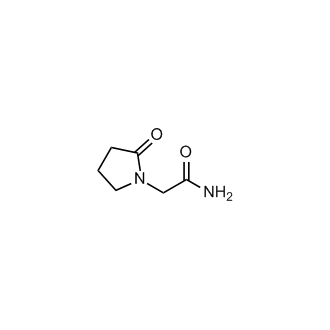| Size | Price | Stock |
|---|---|---|
| 500mg | $55 | In-stock |
| 1g | $73 | In-stock |
| 5g | $106 | In-stock |
| 10 g | Get quote | |
| 50 g | Get quote | |
| We match the lowest price on market. | ||
We offer a substantial discount on larger orders, please inquire via [email protected]
or Fax: (86)21-58955996
Inquiry for price and availability only. Please place your order via our email or fax.
| Cat. No. : | HY-B0585 |
| M.Wt: | 142.16 |
| Formula: | C6H10N2O2 |
| Purity: | >98 % |
| Solubility: | DMSO : ≥ 100 mg/mL;H2O : ≥ 50 mg/mL |
Piracetam (UCB-6215) is a cyclic derivative of the neurotransmitter gamma-aminobutyric acid (GABA), used in treatment of a wide range of cognitive disorders. In Vitro: Piracetam (UCB-6215) is able to significantly decrease the fusogenic and destabilising effect of Abeta 29-42, in a concentration-dependent manner. Preincubation of piracetam, at a piracetam/peptide ratio of 960, during 20 min before the addition of Abeta 29-42 prevents almost completely the mixture of the two fluorescent probes. Preincubation of piracetam with lipids prevents almost completely the release of calcein induced by the peptide in a dose-dependent fashion (piracetam/peptide ratios from 9.6 to 960)[1]. In Vivo: Piracetam (UCB-6215) (< 1.0 mM) preincubated with brain membranes enhances membrane fluidity in aged mice, rats and humans, as indicated by decreased anisotropy of the membrane-bound fluorescence probe 1,6-diphenyl-1,3,5-hexatriene (DPH). Piracetam (UCB-6215) (300 mg/kg once daily) significantly increases membrane fluidity in some brain regions of young and aged rats, but has no measurable effect on membrane fluidity in the young rats[2]. Piracetam (UCB-6215) (300 mg/kg daily for 6 weeks) improves active avoidance learning in the aged rats only and elevates membrane fluidity in all brain regions except the cerebellum in the aged rats. Piracetam (UCB-6215) (300 mg/kg daily for 6 weeks) also improves NMDA receptor density in the hippocampus and on muscarinic cholinergic receptor densities in the frontal cortex and the striatum and to a lesser extent in the hippocampus of rats[3].
Lorem ipsum dolor sit amet, consectetur adipisicing elit. Autem earum hic iste maiores, nam neque rem suscipit. Adipisci consequatur error exercitationem fugit ipsam optio qui, quibusdam repellendus sed vero! Debitis.
Inquiry Information- Product Name:
- Piracetam
- Cat. No.:
- HY-B0585
- Quantity:


Your information is safe with us.